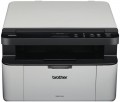First page print
The time passed from pressing the Copy button to the completion of the first copy in MFPs. Typically specified for low quality black and white printing on A4 paper. The time for the first copy to be released is the longest (because of the time to prepare for work and scan the document); subsequent copies of the same document are printed much faster.
Fast first copy time is important if you have to copy documents frequently.
Monthly Duty Cycle
The maximum number of pages that the MFP can print in a month while remaining fully operational.
OPC drum cycle
The yield of the optical photoconductor drum installed in the laser or LED MFP (see "Print Type").
This spec is based on the approximate amount of pages that can be printed on the device without scratches or scuffs on the drum. Such defects lead to artefacts on prints and deterioration in quality, which may eventually require the replacement or refurbishment of the drum. The longer duty cycle, the less often such events will have to be carried out.
Cartridge model
Types of cartridges (both black&white and colour) used in the MFP. Some models of the MFP are able to work with third-party cartridges, but this feature usually refers to undocumented, and the manufacturer's warranty applies only to specific types of cartridges. So, use third-party compatible cartridge models with caution.
Grammage (max)
The maximum grammage that the MFP can print on. The grammage of the paper depends primarily on its thickness; thick paper is strong, but if it is thicker than allowed by MFP's manufacturer, the paper feeder simply cannot handle such sheets.
Scan resolution
The maximum resolution of the MFP scanner. It is usually indicated by two numbers indicating the number of dots per inch (dpi) horizontally and vertically, for example 1200x2400. The higher the resolution, the more dots the scanned image consists of and the smoother the lines on the digitalized copy and the better the fine details it displays. There are the following common resolutions:
600x600,
600x1200,
600x2400,
1200x1200,
1200x2400,
2400x4800,
4800x4800 and even more.
Scanner Colour Depth
The colour depth supported by the MFP scanner. This setting determines the number of colour shades that the device can recognize. Therefore, the overall quality of the scan directly depends on it (although other features of the device also affect this quality).
Of course, it makes sense to be focused primarily in colour depth if you plan to intensively use the scanner for full-colour images like photos, paintings, etc. If the MFP is purchased mainly for documents, where the maximum variety of colours is the logo on the letterhead or the stamp, it barely makes sense to pay special attention to this spec.
As for the colour depth, we note that the total number of recognizable shades can be determined using the formula “two to the power of the number of bits”. For example, a 24-bit scanner will recognize 2^24 = 16.7 million colours (approximately). This value is considered quite sufficient for everyday use, and 36-bit is also sufficient for relatively simple work tasks such as printing brochures and other images that do not require high colour fidelity. But for professional work with colour, you should choose more impressive scanners; in the most advanced models, the colour depth can reach 60 bits.
Feed tray
The maximum number of sheets that can be loaded into the MFP feeder at one time. Blank paper is taken from the feed tray for subsequent printing; the more sheets fit there, the less often you will have to reload the MFP with blank paper.
Output Tray
The maximum number of sheets of paper that can easily fit on the output tray of the MFP (printed materials go there). The more paper fits on this tray, the more materials you can print without having to pick up processed sheets from the tray.

